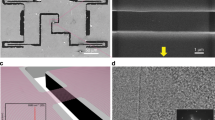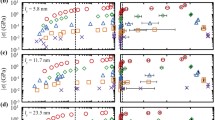Abstract
Purpose
In this work, we investigate the mechanical bistability properties of single-layer graphene under distributed compressive and uniformly out-of-plane loads.
Methodology
The stable configurations and transition processes of bistable graphene are numerically studied based on a multi-scale computational framework. In this study, different graphene with opposite boundary completely clamped support and others free are considered. The evolution of stable morphology and bistable phase switch are examined. In addition, small-scale boundary effect is also discussed in detail.
Results
Our results reveal that the small-scale boundary effect is obvious for small-size graphene under small loads. With the increase of graphene size and loads, the small-scale boundary effect becomes smaller and smaller due to the increasingly dominant structural rigidity when forming the arched graphene.
Conclusions
The arched stable phase of graphene can be exactly controlled by the applied compressive loads. It is found that the bistable graphene with larger arched amplitude can bear much higher load and store more energy before bistable transition. Moreover, the bistable phase switch of graphene is also sensitive to the graphene size.
Graphic abstract
















Similar content being viewed by others
References
Ji D, Wen X, Foller T, You Y, Wang F, Joshi R (2020) Chemical vapour deposition of graphene for durable anticorrosive coating on copper. Nanomaterials-Basel 10:2511
Ahmad H, Fan M, Hui D (2018) Graphene oxide incorporated functional materials: a review. Compos B Eng 145:270–280
Mittal G, Rhee KY, Park SJ, Hui D (2017) Generation of the pores on graphene surface and their reinforcement effects on the thermal and mechanical properties of chitosan-based composites. Compos Pt B-Eng 114:348–355
Kumar R, Singh R, Hui D, Feo L, Fraternali F (2018) Graphene as biomedical sensing element: state of art review and potential engineering applications. Compos B Eng 134:193–206
Eda G, Fanchini G, Chhowalla M (2008) Large-area ultrathin films of reduced graphene oxide as a transparent and flexible electronic material. Nat Nanotechnol 3:270–274
Bunch JS, van der Zande AM, Verbridge SS, Frank IW, Tanenbaum DM, Parpia JM et al (2007) Electromechanical resonators from graphene sheets. Science 315:490–493
Reserbat-Plantey A, Schädler KG, Gaudreau L, Navickaite G, Koppens FHL (2016) Electromechanical control of nitrogen-vacancy defect emission using graphene NEMS. Nat Commun 7:10218
Yi S, He X, Lu J (2018) Investigation on snapping transitions of locally nanostructured bistable disks actuated by distributed transverse forces. Mech Mater 127:91–99
Sun R, Li L, Feng C, Kitipornchai S, Yang J (2019) Tensile property enhancement of defective graphene/epoxy nanocomposite by hydrogen functionalization. Compos Struct 224:111079
Lee S-J, Jeong S-H, Kim D-U, Won J-P (2020) Graphene oxide as an additive to enhance the strength of cementitious composites. Compos Struct 242:112154
Tong L, Lin F, Xiang Y, Shen H-S, Lim C (2021) Buckling analysis of nanoplates based on a generic third-order plate theory with shear-dependent non-isotropic surface stresses. Compos Struct 265:113708
Lin F, Tong L, Shen H-S, Lim C, Xiang Y (2020) Assessment of first and third order shear deformation beam theories for the buckling and vibration analysis of nanobeams incorporating surface stress effects. Int J Mech Sci 186:105873
Tong LH, Wen B, Xiang Y, Lei ZX, Lim CW (2021) Elastic buckling of nanoplates based on general third-order shear deformable plate theory including both size effects and surface effects. Int J Mech Mater Design 17(3):21–543
Rong D, Fan J, Lim C, Xu X, Zhou Z (2018) A new analytical approach for free vibration, buckling and forced vibration of rectangular nanoplates based on nonlocal elasticity theory. Int J Struct Stab Dyn 18:1850055
Yan JW, Lai SK, He LH (2019) Nonlinear dynamic behavior of single-layer graphene under uniformly distributed loads. Compos B Eng 165:473–490
Yan J, He J, Tong L (2019) Longitudinal and torsional vibration characteristics of boron nitride nanotubes. J Vib Eng Technol 7:205–215
Li C, Zhang N, Fan X, Yan J, Yao L (2019) Impact behaviors of cantilevered nano-beams based on the nonlocal theory. J Vib Eng Technol 7:533–542
Li C, Yu Y, Fan X, Li S (2015) Dynamical characteristics of axially accelerating weak visco-elastic nanoscale beams based on a modified nonlocal continuum theory. J Vib Eng Technol 3:565–574
Li C (2016) On vibration responses of axially travelling carbon nanotubes considering nonlocal weakening effect. J Vib Eng Technol 4:175–181
Bao W, Miao F, Chen Z, Zhang H, Jang W, Dames C et al (2009) Controlled ripple texturing of suspended graphene and ultrathin graphite membranes. Nat Nanotechnol 4:562–566
Lu Q, Huang R (2009) Nonlinear mechanics of single-atomic-layer graphene sheets. Int J Appl Mech 1:443–467
Sakhaee-Pour A (2009) Elastic buckling of single-layered graphene sheet. Comput Mater Sci 45:266–270
Pradhan SC (2009) Buckling of single layer graphene sheet based on nonlocal elasticity and higher order shear deformation theory. Phys Lett Sect A Gen At Solid State Phys 373:4182–4188
Shahabodini A, Ansari R, Darvizeh M (2017) Multiscale modeling of embedded graphene sheets based on the higher-order Cauchy–Born rule: nonlinear static analysis. Compos Struct 165:25–43
Frank O, Tsoukleri G, Parthenios J, Papagelis K, Riaz I, Jalil R et al (2010) Compression behavior of single-layer graphenes. ACS Nano 4:3131–3138
Farajpour A, Mohammadi M, Shahidi AR, Mahzoon M (2011) Axisymmetric buckling of the circular graphene sheets with the nonlocal continuum plate model. Phys E 43:1820–1825
Shen H-S, Xu Y-M, Zhang C-L (2013) Graphene: why buckling occurs? Appl Phys Lett 102:131905
Shenoy VB, Reddy CD, Ramasubramaniam A, Zhang YW (2008) Edge-stress-induced warping of graphene sheets and nanoribbons. Phys Rev Lett 101:245501
Jia X, Hofmann M, Meunier V, Sumpter BG, Campos-Delgado J, Romo-Herrera JM et al (2009) Controlled formation of sharp zigzag and armchair edges in graphitic nanoribbons. Science 323:1701–1705
Jiang J-W, Wang J-S (2012) Why edge effects are important on the intrinsic loss mechanisms of graphene nanoresonators. J Appl Phys 111:054314
Jiang J-W, Park HS (2016) Negative Poisson’s ratio in single-layer graphene ribbons. Nano Lett 16:2657–2662
Pirmoradian M, Torkan E, Abdali N, Hashemian M, Toghraie D (2020) Thermo-mechanical stability of single-layered graphene sheets embedded in an elastic medium under action of a moving nanoparticle. Mech Mater 141:103248
Chen Q, Zhong Y, Zhang Z, Zhao X, Huang M, Zhen Z et al (2018) Long-term electrical conductivity stability of graphene under uncontrolled ambient conditions. Carbon 133:410–415
Jalaei MH, Arani AG, Tourang H (2018) On the dynamic stability of viscoelastic graphene sheets. Int J Eng Sci 132:16–29
Guo J, Jiang L, Jia Y, Dai X, Xiang Y, Fan D (2017) Low threshold optical bistability in one-dimensional gratings based on graphene plasmonics. Opt Express 25:5972–5981
Zhang D, Sun Z, Ding C, Yu R, Yang X (2016) Controllable optical bistability and multistability in a graphene monolayer system. J Lumin 170:72–77
Zhang K, Huang Y, Miroshnichenko AE, Gao L (2017) Tunable optical bistability and tristability in nonlinear graphene-wrapped nanospheres. J Phys Chem C 121:11804–11810
Yan JW, Liew KM (2015) Predicting elastic properties of single-walled boron nitride nanotubes and nanocones using an atomistic-continuum approach. Compos Struct 125:489–498
Yan JW, Liew KM, He LH (2012) Predicting mechanical properties of single-walled carbon nanocones using a higher-order gradient continuum computational framework. Compos Struct 94:3271–3277
Yan JW, Zhang LW, Liew KM (2016) A multiscale computational framework for the analysis of graphene involving geometrical and material nonlinearities. Comput Methods Appl Mech Eng 310:208–232
Wang JB, Guo X, Zhang HW, Wang L, Liao JB (2006) Energy and mechanical properties of single-walled carbon nanotubes predicted using the higher order Cauchy–Born rule. Phys Rev B 73:115428
Guo X, Wang JB, Zhang HW (2006) Mechanical properties of single-walled carbon nanotubes based on higher order Cauchy–Born rule. Int J Solids Struct 43:1276–1290
Arroyo M, Belytschko T (2004) Finite element methods for the non-linear mechanics of crystalline sheets and nanotubes. Int J Numer Methods Eng 59:419–456
Yan JW, Liew KM, He LH (2012) A mesh-free computational framework for predicting buckling behaviors of single-walled carbon nanocones under axial compression based on the moving Kriging interpolation. Comput Methods Appl Mech Eng 247–248:103–112
Tersoff J (1988) New empirical approach for the structure and energy of covalent systems. Phys Rev B 37:6991–7000
Brenner DW (1990) Empirical potential for hydrocarbons for use in simulating the chemical vapor deposition of diamond films. Phys Rev B 42:9458–9471
Lei G (2003) Moving kriging interpolation and element-free Galerkin method. Int J Numer Methods Eng 56(1):1–11
Bui TQ, Ngoc Nguyen M, Zhang C (2011) A moving Kriging interpolation-based element-free Galerkin method for structural dynamic analysis. Comput Methods Appl Mech Eng 200:1354–1366
Yan JW, Liew KM, He LH (2012) Analysis of single-walled carbon nanotubes using the moving Kriging interpolation. Comput Methods Appl Mech Eng 229–232:56–67
Bui TQ, Nguyen TN, Nguyen-Dang H (2009) A moving Kriging interpolation-based meshless method for numerical simulation of Kirchhoff plate problems. Int J Numer Methods Eng 77:1371–1395
Bui TQ, Nguyen MN (2011) A moving Kriging interpolation-based meshfree method for free vibration analysis of Kirchhoff plates. Comput Struct 89:380–394
Yang X, Wang C, Lai S (2020) A magnetic levitation-based tristable hybrid energy harvester for scavenging energy from low-frequency structural vibration. Eng Struct 221:110789
Yan JW, Lai SK (2018) Superelasticity and wrinkles controlled by twisting circular graphene. Comput Methods Appl Mech Eng 338:634–656
Acknowledgements
The work described in this paper was fully supported by the research Grants from Natural Science Foundation of China (Grant nos. 12072112), National Natural Science Foundation Excellent Youth Cultivation Project (Grant no. 20202ZDB01001), China Postdoctoral Science Foundation (No. 2021M700306), and Natural Science Foundation of Jiangxi Province (Grant no. 20202ACBL214014 and 20202ACB211002), and Primary Research & Development Plan of Jiangxi Province of China (20212BBE53016).
Author information
Authors and Affiliations
Corresponding author
Ethics declarations
Conflict of Interest
We confirm that the manuscript has been read and approved by all named authors and that there are no other persons who satisfied the criteria for authorship but are not listed. We further confirm that the order of authors listed in the manuscript has been approved by all of us.
Additional information
Publisher's Note
Springer Nature remains neutral with regard to jurisdictional claims in published maps and institutional affiliations.
Rights and permissions
About this article
Cite this article
Yan, J.W., Xiong, M., Tong, L.H. et al. Spontaneous Arched Graphene Under Uniaxial Compression and Bistable Interswitch Behaviors of Single-Layer Graphene. J. Vib. Eng. Technol. 10, 445–458 (2022). https://doi.org/10.1007/s42417-021-00360-4
Received:
Revised:
Accepted:
Published:
Issue Date:
DOI: https://doi.org/10.1007/s42417-021-00360-4




